Rebecca Ashton concludes her extraordinary series of articles with Australian dressage star, Brett Parbery. In this episode, Brett outlines his plan to turn around the future of Australian dressage….
Brett Parbery is a dreamer. He’s the first one to admit that. However, where Brett is different to most theorizers is that he puts solid action behind those ideas. He has big plans for Australian dressage and is getting things going on a micro-level with his own procedures and systems that he hopes might catch on ripple over nationally.
“I spend a lot of time thinking about how we can get dressage better from this side of the planet. In Australia we don’t have all those heads that get together at all the shows like in Europe. Overseas they’re all good friends, they work together, they get together at the shows and they ask each other about horses. Even if they’re from different countries, they have a beer and discuss ideas. ‘I have a horse, it doesn’t piaffe so well……have you tried this or that?’”
“We don’t have that here as much because we’re on the other side of the world and I think also we’re all just so busy trying to make a dollar. I have always found, every time I come back from a training stint in Europe, I have a really good focus and attitude. Then over time it starts to evaporate and you start getting molded by your environment. I’ve been trying to put my finger on why that is.”
“I think one of the problems we face in Australia is that our dressage environment is not set up for the production of world class combinations. It’s nobody’s fault, and no one is to blame, it’s just the way it is. I often ask people this question, ‘Do you think that if we put any of the current top five riders in the world in the same position as any of the current top five riders in Australia, living here with limited coaching, nice shows but not big world class events, footing issues at many of our venues, inconsistent judging through the levels, work and finance issues, do you think they would become better or worse riders?’ I think we all would agree that their talents would decline over time. My next question is then, ‘How can we expect our riders to become better in an environment where we all agree the best in the world would become worse?’”
“So, we need to ask ourselves, ‘How is it possible to get our riders better focused and achieving higher scores?’ Firstly I think we need to have a big group of people all pushing each other in a good way with healthy competition. From my days in rodeo, healthy competition does not come about from disliking your competitors, or trying to undermine them. It comes from camaraderie and boosting other people so that you have to be better yourself. If undermining your competitors and being nasty was such a great strategy, why hasn’t it worked to date? It hasn’t.”
“So, let’s try the other way. Let’s try to enjoy our life and the sport and help one another. That doesn’t necessarily mean telling each other that we’re good and telling lies to each other, but being honest in a positive way.”
“I think the true key to development here is being able to self analyse. Having tools that help you to self analyse, whether that’s eyes on the ground constantly, or whether it’s getting yourself videoed all the time, or having a set of aids that you can check yourself on, self analysis is the only way you get progression. If someone can help you do this without stripping away your confidence to make you better, and therefore also make themselves better, I think that’s the way forward.”
“As a result, I have recently come up with an idea for my own high performance training system. I don’t think what is offered by the national organisation is broad enough. They simply just don’t have the funds to help us. I’m getting a couple of people involved and have a ‘head coach’ or chief organiser as-it-were who isn’t a dressage person, but has a lot of experience in high performance. It’s very new and still in the experimental stage.”
“I believe there are four key elements to a successful high performance program:
– Both the horses’ and riders’ bodies must be in the best physical condition to take on the challenge.
– Rider skill development
– A thorough and continuous review process
– Inspiration to keep pushing the limits
“The horse’s physical and mental wellbeing needs to be monitored. Management such as having regular body work for the horses, correct shoeing, regular dental checks, soft tissue treatments, x-rays and training logs made. It’s important to view the horse as the elite athlete he is. The horses must be pain free and content, before they will offer complete willingness.”
“As a rider and trainer, I was happy with my training system, but I wasn’t happy with the quality of kilometres I was putting into my training. For example, if you have a tight hip and you’re doing a lot of kilometres riding with a tight hip, your horse has to compensate for your body and it affects him negatively. Ever wondered why sometimes you give your horse time off and he feels great when he comes back to work? I think sometimes the fact that he hasn’t been carting around your misalignments has something to do with it. I think work on body symmetry and constant improvement to rider position is important. It also helps to stop bad habits creeping into the training.”
“Rider skill development is essential. It doesn’t matter how good a rider we become, we can always improve. It’s important that we never lose sight of developing our skills and this can be done by getting more lessons from varied coaches, but also identifying which skill you need to improve, and going and finding the answer yourself.”
“Once you then acquire the skills and start working on them it is extremely important to keep reviewing your performance and measuring it against pre-assigned key performance indicators (KPI’s). Video review is great for that. We dressage riders are usually our own worst critics and I’m no exception. I really dislike watching myself on video, but I have to make myself do it to keep the review process consistent. I have been playing with the idea of maybe one day being able to ride a dummy Grand Prix test, and then send the footage overseas to an international judge who could possibly judge it, and send the comments back to me the next day. The results and even individual movements could be graphed so I could identify my weak areas, and therefore aim at meeting my KPI’s before the show, not at the show as I currently do. I think this could be great for the review process and possibly one way we could keep up with the European standard. But at this point none of that is available but it is something to think about for the future.”
“When it comes to inspiration, there are a number of ways to go about it. The Europeans have great shows that usually have tough competition, so that keeps them inspired to push themselves. In the absence of that, things like regional training groups and bigger events incorporating the three Olympic disciplines. For example, a team event concept putting all of our top riders from all three disciplines into teams of three, one from each discipline and riding against each other, could possibly assist to create inspiration. About 15 months ago I decided to bring a group of riders together to mix socially, but to also discuss business and the direction of the sport. We called it the Book Club.”
One of ‘The Book Club’ get-togethers…
We live in the Southern Highlands and are very lucky in the sense that very good professionals live close by to us. I was riding around one day in the arena and I thought to myself, “You know what? I’m sick of this whole thing where none of us really catch up and the only time we see each other is at shows where we’re all busy. I actually want to sit around a table with people I respect and discuss ideas.”
“I rang around, and it’s not as if we’re all close friends, but we do have a common interest. We have a lot of experience between us and put in the same room, we have a great time, but we’re not living out of each other’s pockets. There’s Matthew Dowsley, Rodney Martin, Dave McKinnon, Robbie Soster, Sue Hearn, Andrew Hearn, Michelle Baker, Kelly Rolland, myself and Mel, Mark Dowling and Ally Soster. Of that, eight are riders.”
“So, originally we got together as a dinner group and decided we should get together every four to six weeks or so. I thought that we could all get together and solve a few problems; I need some stuff, you need some stuff, where are you buying your hay? Can we buy it cheaper if we buy it together? All those little things that working together would improve. We were all joking around, thinking of names for the group. The Saddle Club didn’t cut it but The Book Club stuck.”
“I then wondered if I should put it to the guys that we train together, because I actually want to enjoy the journey on my horses and I don’t want to feel like I’m doing it on my own. After a couple of our dinner gatherings, we were all getting on well, I put it out there to them. ‘Here’s the next chapter of this social experiment! How would you guys feel if we all trained together once a month or so?’”
“They said no, they didn’t think it would work and they didn’t want to break up the fun thing we had going. And I’ll give them credit, they trusted in me a bit because it was an experiment. The last thing I wanted was to have people upset by it. You’re never quite sure how these things are going to turn out.”
“When we’re in the arena, it has nothing to do with friendships. We actually all want the same thing; we all want to get better and we want to get our horses better. So we tried it, but the one thing we had to break down, what could be misconstrued was when someone was giving advice, it was not someone being critical.”
“We all know that sometimes in riding, things have to get worse before they get better and it was just making sure that everyone knew that. What someone suggests might feel worse, but it will eventually be better. So I suggested that we all nominate someone to be our training partner. Your partner is someone who works closely with you, and you share your deep, dark secrets with them and they help you source information within the group to make you better.”
“That doesn’t mean that they are your coach. Your coach can be anyone in the group or the coach away from the group you want to stick with all the time. Your training partner is going to help you break down info that’s come from your session and help you follow it up in the weeks after. ‘Those changes that you worked on…how are they going? Have you thought about what Matthew said?’ sort of thing.”
“Everyone chose a partner and away we went. The first couple of sessions all felt a bit awkward. So, we put the radio on, two people rode at a time and we just started training, we started talking. It continues like that now. Everyone else is either out getting their horse ready or sitting in the corner. We don’t all stand around throwing our two bobs in.”
“So, for example one session I said to Michelle Baker (who is my training partner), I want to work on my ones. Michelle said, ‘He’s not through enough.’ So we grabbed Matthew and Matthew commented, ‘No, you’ve got to have him rounder, more through and come back to trot, canter transitions.’”
Brett and DP Weltmieser, champions at the 2015 Sydney CDI
“Away we went, more over the back, more through, a little zigzag work and getting the horse to use its body better, get his neck lower. They took me from the original plan of the ones, back to where they thought the root of the problem was, Matthew via Michelle and Rodney chipped in a bit as well. I have no doubt that made it better. It was fantastic. That’s it working in a good way. Then I came away and we had a dinner a couple of weeks later and touched base.”
“There’s many ways this can work. The underlying thing is having a camaraderie. I still don’t think we’re using it to its full potential. We’re all still experimenting.”
“There are some really good things that have come out of it though. For example, at the Nationals last year, Robbie and Michelle were the first out in the Grand Prix freestyle and they went bang, bang; 67% and 67%. That made the whole night of freestyles tougher. Everybody had to be at their best. I had no one warming me up. Rodney was walking past and he jumped in and helped me.”
“If someone knows where you’re at, and what you’re up to, we can kind of change who works with whom. That can be really helpful. We went to Orange CDI and Robbie had had a bad ride at Bowral the week before. She wasn’t going to go to Orange but we all rallied around her and said, ‘No, you’re going.’ She went and got a personal best. There’s a lot of that. We’re around each other for the good times and the bad times.”
“When you compete and people are on your side, it makes you braver to take more risk. Sure, things don’t always go right, but you start pushing yourself out of your comfort zone. Whenever you’re in your comfort zone you’re only ever going to get the score you always got. You can only go further if you take risks. You’re more likely to do that if you have supportive people around you.”
“There is always talk about whether we need to get the European-based combinations to come back to Australia to qualify for the team. I’m partly for it, and partly not for it. Not for it in the short term, because while the European riders are the strongest competitors for Australia, we can’t ask them to come back. They’re holding the cards really. We as a group of Grand Prix riders in Australia need to get better to a point that we are the strongest of the Australian passport riders. It’s not about “them and us”. They’re good because they’re amongst the good riders and are being pushed. We need to develop that here. So if we can do that with things like ‘The Book Club’, working together, going to shows, developing a detailed high performance system, we’re in a better position. I also think it should be more a northern hemisphere/ southern hemisphere thing. We need to work together with New Zealand as well.”
“If we look at the equestrian calendars in both countries, Australians can compete in New Zealand, and New Zealanders can compete in Australia, and we can push each other. I just had all the New Zealanders here prior to the Sydney CDI and we talked about this. It will make for tougher competitions, and then it would be great for the dressage public if we could have the European based riders come back here. It would be good for them to see that.”
“If we want to leave a legacy of camaraderie, training system, clarity, Australia as one, we should be able to sit back in the stands when we’re retired and enjoy what we’re seeing, not criticising it. If not, we haven’t done our job properly.”
Brett goes through an iPad video with student Katharine Farrell
“I talk a lot about Equestrian Australia needing a slogan like, ‘One Sport, One Team’. If we want to make Australia number one at something in the world in equestrian, let’s make it that we are the best at working together in very smart and very efficient ways. Let’s become more innovative in our coaching, having our high performance coaches working with our event organisers, working with all the different disciplines and having them all work together. I believe that is the strategy that must come from the national board. All the little factions and infighting; if they’re not together in the boardroom, you cannot expect the sport to be together.”
“Who would want to be a selector, for example? You get shot down whenever there’s a selection event on, social media goes mad, everyone’s an expert until they try to do it. No one wants to be a selector and how do you blame them? No matter how black and white you make a selection policy, there’s always going to be a scenario that will test it. Add to that uninformed opinions, why would you want to do it?”
“I think we need to turn up at a big world event and have other countries look at us and think, ‘Man, those guys are going somewhere. They’re running a very exciting form of the sport and they’re united in the way they approach this.’ When your strongest combinations are coming out of Australia, that is when your sport is at its best. That’s nothing against the girls based in Europe. They’re there because they want to bring the best out in themselves and they think that’s the way to do it. Give me half a chance I’d be there too.”
“At the moment, the showjumpers are all based overseas, the eventers are predominately based overseas, the dressage riders are all based over there. That’s not great for what is going on here. We need to pull together and it has to start in the boardroom. The longer they talk about Hendra, the longer they talk about ICT platforms and all that stuff, the more they try to micromanage….they’ve wasted so much time over the years. Hopefully it will change, but need to be united, and focus on the sport, and get to where we need to be in the high performance field.”
“Then, when that kid comes out of Pony Club, forget ‘Ready, Set, Trot’ – that program is about kids getting a helmet on and pretending they have a horse trotting around. What we really need is to find the kid in Pony Club who wants to go on with horses, ‘Where do I go? Do I go to polocrosse, do I go western? I want to go equestrian because those guys look like they’re together, the events are exciting and they go to the Olympic Games.’”
“There are the kids we need to drag into equestrian, and we are not going to find them through ‘Ready, Set, Trot’. Is it a surprise we have all the problems that we have? That’s where I’m hoping that the incoming board goes right back and starts from a “one team” basis.”
“I still believe that the quality of coaching in this country is there. In The Book Club, I’ve said to those guys, I don’t want to go to a clinic with an international guru, I want to trust in my Book Club members. We need to take ownership of our own training and our own system. This will work better than having the next big guru come out and inject two days of information. I don’t know whether I’m living in Lala Land or not…”
What “The Book Club” members think: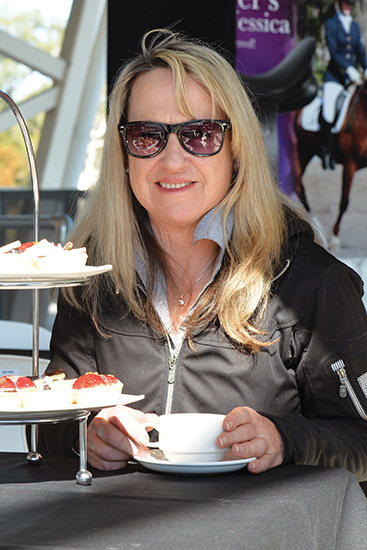
SUE HEARN
“I think it is more about swapping little ideas. We are all very friendly, we are all very open to new things, and I think you have to be. Little comments can help so much, oh I did this with this horse – and that makes a big difference – and of course, we all drink a lot of wine, that makes it even more friendly.”
“Finding a time when everybody can be together is tricky when we all have to work for a living, but when we get together it is really good. When we are at a show, if there is one of the group on the side, we know they can help. It’s not some strange person helping you, it is someone you are used to. Like Rodney Martin came and helped me at Sydney, and it just blew me away. Not changing anything, but just the confidence, he’s seen the horse go and knows how to help.”
“Our dinners are hysterical… it seriously is like everybody talking, all at once, quite crazy. It’s a My Kitchen Rules thing, you have to out-cook the person before you, come up with something pretty good – there’s no running out to the pizza place.”
“All of the group in The Highlands, no one has tickets on themselves, we all know how hard it is to train a horse to Grand Prix and to keep it sound. We all have to work for a living, there’s none of us who have been given anything. We are all working out ways of saving money, earning money, trying to keep our businesses going. Like Dave McKinnon is trying to get cheaper hay, getting a bulk deal, cheaper feed, finding little ways, little ideas, to help each other.”
“Brett’s wants to make us Southern Highlanders the best in Australia! We’re pretty fortunate having a group of really good riders down here and we all want to help each other.”
“Everybody does things differently and it’s always beneficial to have another viewpoint. You might be having a problem with one thing and your way of fixing it might not quite work, and someone else, especially someone who doesn’t see you all the time, might have a method that does work.”
“Everyone’s so busy and we can’t do it all the time but we do it as much as we can and then we’ll try and have a dinner and discuss each horse. We’ve also started doing videos and we’ll have a video night from say a judge’s point of view. We’ll ride a test and then people will talk about the movements and about what marks they would give and why. Just trying to help each other a bit.”
“It’s good for the green ones. I can go to Mark Dowling’s place and get them used to an indoor and the sound system. It’s really good to get them off the property. I try to take a different horse every time. It’s not a full on lesson as such it’s just for instance Sue and Brett watching and Brett might say to Sue, ‘What would you do with that?’ And Sue would give her opinion and Brett might have a different opinion, so you might try both ways, plus your own way, and see what works best.”
“I think at comps helping each other is what we need. Matthew might be doing something at the same time as me, because we usually have so many horses at a show. If someone from the group is around, they might come up to me and say, do this or do that in the warm up. And I do the same. If I see Brett warming up and I think that could be better, I’ll say just do this, Brett.”
“It’s really good like that, and no one seems to take offense. We are all just trying to get the most out of our horses. We are all open-minded so we’re willing to take a bit of criticism. We’re not so set in our ways. I think when you start to think that you’re better than someone else, that’s when things start to go wrong. When you stop learning you might as well retire. I’m always willing to take any criticism or advice.”
Who’s the best cook?
“Me! Haha. Mel is a good cook to. Everyone does a great job really. Actually we drink more than we eat. I bet if you asked each person in the group no-one would be able to tell you what we had at each person’s place. We’ve got a waiting list of people wanting to join!”
DAVE MCKINNON
“I worked for Brett for two years after Kentucky and we’ve been good friends since then. The whole Book Club just sort of evolved, there was no sign up or anything like that, it just started as dinner and an idea with the riders in our area. The training sessions came later. As the youngest riders, it’s hard for Robbie and I to teach any of the other guys how to do anything because they all know so much more than us. They coach us but our role is more to be eyes on the ground and doing some videoing.”
“Even when you’re back home, it’s great because instead of riding on your own trying to come up with solutions, you have all their voices in your mind. You feel the support from those guys even if they’re not there all the time. You know they’re there barracking for you.”
“It’s also much better at competitions. Before the club you were on your own, but now we all try to get the same stable aisle and there’s someone to help you warm up. It’s just a better and more supportive atmosphere.”
“The dinners are really like My Kitchen Rules type of affair. I don’t want to say who I think the best chef is. Everyone is pretty good!”
This article first appeared in the October 2015 issue.

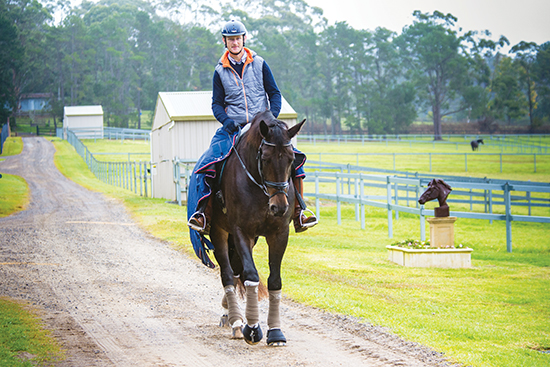
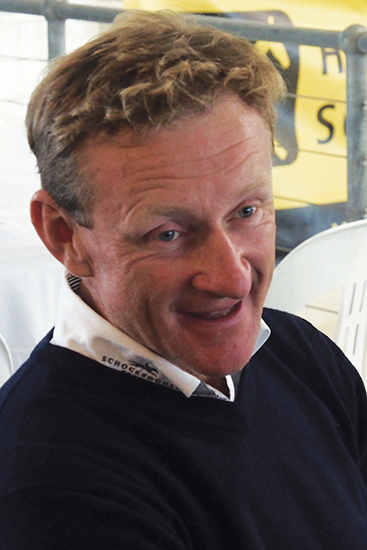
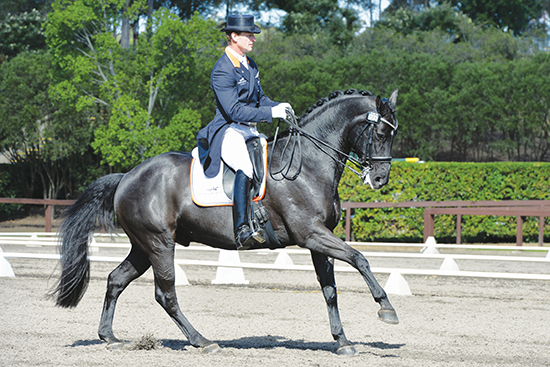
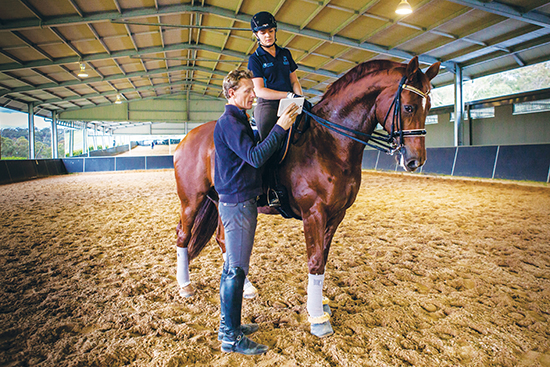
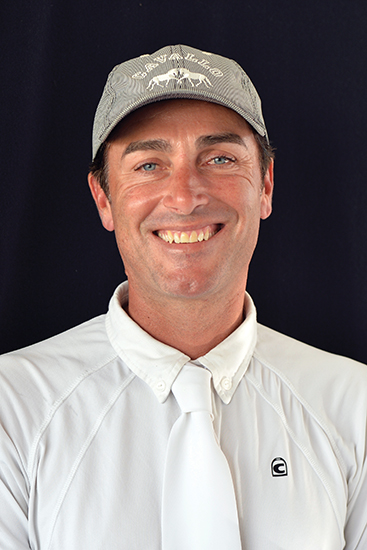
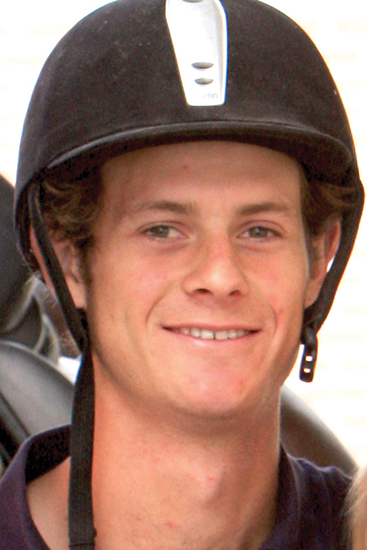
I think this is a wonderful idea not just for dressage riders but also for dressage horse breeders to get together on a social basis and discuss ideas to improve the quality of the horses we breed here in Australia.
I applaud you Brett for saying it how it is!!!!. You have hit the nail on the head! Australian Riders who aspire to go International, need to follow your model!.
Forget EA, – they have not met the needs of the Riders, Owners, Trainers and Sponsors – whilst the Australian Overseas based Riders are the ones getting the European Coaching, Competitions, Professional Development etc., the Australian based Riders have a huge uphill battle to try to be selected for International Competition, then they have to find enormous amounts of $$$$$$$ to travel, as EA does not help.
What happens to the up and coming Australian based Rider, who wishes to compete at International Events?. At present, they have to go overseas, because they cannot afford to stay in Australia, to qualify, and then travel overseas to compete.
Also, you are very correct in saying that Australian Riders need to get together to help each other. This is the model the UK based themselves on, using their best Riders to mentor, and develop other UK Riders. The UK also supported the development and rise of the UK onslaught to reach the top on the International Equestrian Stage, by assisting with the Funding of their Riders and their development.
Australia needs more professional Riders like you and your Group, to force positive change toward the development of an Australian Based Equestrian Team.
My husband and I have imported a Premium Classified Trakehner Verband Filly, 4yr old, who has achieved 5 excellent Young Horse Qualifying Scores for the 2016 Young Horse Championships in only her 3 competitions since breaking. She has been competed by her breaker Brett Peel. He and we are thrilled. We have also purchased a Premium Registered Trakehner Verband Colt, who remains in Germany at present. We will make decisions on whether to bring him out to Australia, depending upon EA and the direction they choose to make. We would love to bring him to Australia to be competed. At present, we are thinking we will buy our horses o/s and keep them there, due to the issues YOU have raised, that are current in Australia. Certainly we would love our horses to represent our Country, BUT, the issues you have raised, seem to be getting worse, and EA certainly is not helping matters by mis-directed funding. We are seriously thinking of sending our filly back to Germany also.
Owners like myself and my husband, would like to see a Major Change, in the Mentorship, Development, Sponsorship, and Funding to our Australian Based Riders who are at International Level, but who cannot afford to go o/s, and are somewhat isolated in regard to Professional Mentorship and Critique. It will be a huge shame, for owners such as us, to have European Riders competing our horses, because Australia and EA cannot make positive changes similar to the UK and develop an Australian based International Equestrian Team, that is Funded by EA and Sponsorships, and is supported by every Australian Equestrian enthusiast.
the book club…. still looking for outside help aboard .. still isnt that losing Australian traditions …..
Right on the money i am a level 1 general coach i teach equestrian at private schools and also local pony clubs i have said we need to nuture these kids for years but the system doesnt give an outlet to get them assessed if they show promise so they slip thru the system usually because its such an expensive sport for lessons and most patents dont have the finances. A well written article i woud encourage ths also in victoria .
Funny thing.
Yesterday Sharon Harvey arranged a meeting of the four of us who ran the Dressage Unravelled Clinic last Easter. Brett was one of the coaches there. It was very different, not high performance and extremely successful.
Her first words at the meeting were ” we need to develop a system of dressage training that suits Australians”!!
We came away with a concept for a Dressage Hub based at QSEC, similar to the Schools of Excellence we have here in our secondary schools for Music, Art, Arts etc.
We are now going away and developing the concept into a presentation format to take forward.
Great minds!!
I’m so jealous ! Stuck out in Aberdeen with out a book club and too far away from you guys to travel up and down So in mentioning that how difficult is it to arrange week long camps down with you guys where maybe we can meet like minded people in our location and then set up a subsidiary office/club
I’m fiends with Mary Ann Crabtree who as you would know is a Board member at EA if you don’t mind I would love to send her a copy of your ideas
Thanks Bret
Regards
Julie Pulford
Hi Brett, Love your concept and can only say we in regional Queensland feel and hear you. It is so hard to organise regular clinics up here as 1. the cost most times is prohibitive what with flights, accomodation and then the lesson on top….2. distance to travel to clinics….3. to actually get clinicians to our area on a regular basis. We have very few higher level riders in this area that it would be fair to say(in my opinion only) that the time and effort to organise camps…clinics of 2 or more days and rally people to attend to not only benefit themselves but others, would come at a stretch. Unfortunately it is then left to individuals to try and progress through the ranks with little outside help. So encourged when I read your article, and can only dream that I was 30 years younger and lived well south of the border. Keep up the good work and you have a volunteer in me if you ever need one.
Cheers
Gayle Bell
Finally our top riders have got it. “We need to help each other and learn more” I have said for a long time that the closed to learning minds have held our top riders back. Brett I could not agree more with you approach to get there.
Gisela Nilsson-Harding FEI 3* judge
Most important issue for all dressage riders, trainers, clinicians and judges to adhere to the rules and directives.
That is not done currently….horses are overbent and behind the vertical and DO NOT appear to be doing it of their own accord. Poll high and ‘head’ in front of the vertical means exactly that and in the FEI Dressage Judge’s Handbook on page ten it clearly defines this by stating the following:
“Broken arch in the neck. This occurs as a result of the rider attempting to establish contact by using the hands in a backward direction. The highest point is no longer the poll but a point further back, usually between the and second and third vertebrae.”
What does this say about the judging? The broken neck has become the accepted standard.
If a rider is pulling backward the rider is applying the brakes. There is absolutely no other available action and thus is giving the horse different aids of forward and braking. As such each and every gait could not be pure by any sense of the word, nor could the horse be balanced.
I know there are many other directives, however, this particular one should have the most influence upon all the other directives. Why? Simply that one of the prime directives state that the horse – ‘appear to be doing it on its own’ – CANNOT be met what so ever. Therefore, all aspects of the movements and gaits of the test cannot be achieved to any degree of high standards and the scores should reflect that, i.e. being in the range of 60’s maximum and that is for GP.
Correct means correct. The rules and the directives stipulate what is correct and therefore must be met. Anything less is a disgraceful act against the purity of dressage in the competitive arena.